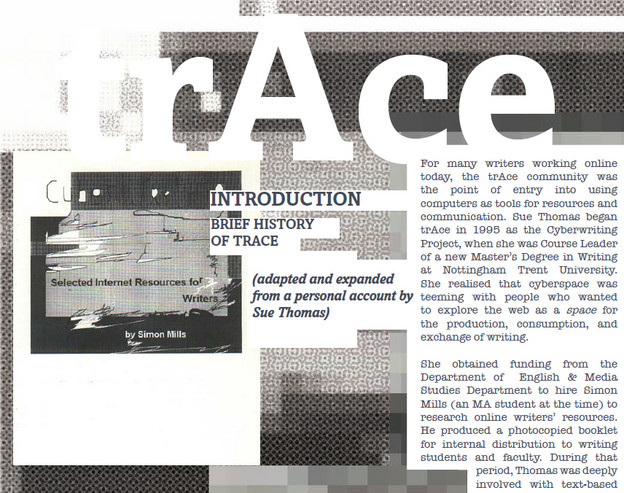Traces of the trAce Online Writing Centre 1995-2005

Since its foundation in 1995 by Sue Thomas at Nottingham Trent University, UK, under the short-lived name CyberWriting, the trAce Online Writing Centre has been a shifting morphing hybrid entity. Its first output was a word-processed photocopied booklet called Select Internet Resources for Writers, compiled in Summer 1995 by Simon Mills, who went on to build the first trAce website, which launched at the Virtual Futures Conference at Warwick University in May 1996. For the next decade trAce expanded along with the web, evolving organically and somewhat haphazardly into a vast interlinked network created by many different artists, authors and researchers, during a period of rapid technological change.
Between 1995 and 2005 the trAce Online Writing Centre hosted and indeed fostered a complex media ecology: an ever-expanding web site, an active web forum, a local and and international network of people, a host of virtual collaborations and artist-in-residencies, a body of commissioned artworks, the trAce/Alt-X International Hypertext Competition, the Incubation conference series, and frAme, the trAce Journal of Culture and Technology. What emerged was one of the web’s earliest and most influential international creative communities. Its members were diverse, ranging from media-curious workshop participants to artist-in-residencies by some of the most well known practitioners in the fields of new media and digital writing today. What they had in common was that used the internet as a medium and a meeting place, platform to generate, disseminate and debate new media writing writing practices.
To give a full account of the history and output of this one-of-a-kind moment-in-time community would take an eternity. Fortunately, there is no need. Fittingly, considering its humble beginnings with photocopy, among the last outputs of the trAce Online Writing Centre was also a booklet of sorts, this time a full-colour fully-down-loadable PDF one: trAces: A Commemoration of Ten Years of Artistic Innovation at trAce.
My aim here is to draw attention to the vast and varied remains of the trAce Online Writing Centre, which have been collected together in a unique archive containing a large, diverse and search-able collection of work published by the trAce Online Writing Centre between 1995 and 2005. All the major works commissioned by trAce between 1995-2005 are there, as well as Incubation conference proceedings and the contents of frAme, the trAce Journal of Culture and Technology, which featured early works by Mark Amerika, M.D.Coverley, Matthew Fuller, Geert Lovink, Talan Memmott, Mez, Melinda Rackham, and Francesca da Rimini. The trAce forums are archived at: http://tracearchive.ntu.ac.uk/forums/ More information about the contents of the archive can be found here: http://tracearchive.ntu.ac.uk/about.asp
What’s interesting about this archive is how very much it reflects the context of its creation. Many of the names in it are well known to us today, many more are not. A significant number of works in the archive were built in collaboration and depended heavily on contributions sent in from writers around the world. These include: The Noon Quilt (Teri Hoskin, Sue Thomas, Ali Graham, 1998-1999), Imaginary Post Office (Randy Adams 2000), and In Search Of Oldton (Tim Wright 2004). The archive also contains a wealth of ForumLive & Online Meeting MOO/Chat logs. Invaluable not just as records of what was being said in them, these carefully transcribed conversations also evoke the syntactic context of their creation. A glance at the following excerpt of a transcript of a bit of chitchat which took place prior to chat on Erotic Hypertext which took place Sunday November 19th 2000 offers a glimpse into the visual, textual, grammatical look and feel, the lingua franca if you will, of LinguaMOO:
Start log: Sunday, November 19, 2000 12:02:27 p.m. CST
wanderer arrives from Tower of Babble
mez quietly enters.
vika quietly enters.
vika says, "Hello, all."
mez says, "Hey vika"
vika says, "Ah, hello mez. I see you are "all"."
mez says, "Yeah, sorry about that:) negate that qs if possible, yeah?"
mez says, "So we r earli then?"
vika says, "Apparently."
mez says, "So vika, wots yr story?:)"
vika says, "Five more minutes, by my clock."
mez says, "k"
vika says, "Well, it's all in my "bio". :)"
mez says, "Not b-ing a regular MOO boffin, can I ask how 2 check that please?"
vika is very new to the MOO interface and is 'sploring.
The trAce Online Writing Centre supported experimentation with new literary forms, new softwares and and new hardware platforms which are now antiquated. As a result, the contents of th the trAce Archive are wildly uneven. Some works don’t work anymore. Some were experiments which never worked in the first place. Some links are broken, which is sometimes more informative than if they were not, for breakage exposes, breakage reveals. Browsing through Assemblage: The Women’s New Media Gallery, Carolyn Guertin’s showcase of new media writing by women (1999-2005) , for example, I found a dead link to Mythologies of Landforms and Little Girls, a hypertext work I made in 1996 which was exhibited in 1997 by StudioXX, a feminist artist-run-centre in Montreal. Though that particular webserver doesn’t exist anymore, StudioXX is still alive and well. I don’t mind at all that this link is broken. I’m thrilled to discover that it was there at all, to know that in the late 1990s someone way over in England was looking at this early work.
The trAce Archive is full of these sorts of traces. Layer upon layer of dated design aesthetics overlap and peel like wallpaper, revealing earlier versions beneath. The occasional page errors, dead links and missing images are artifacts of the web as it was, a web in progress, a web in the making.
Performing digital texts in European contexts